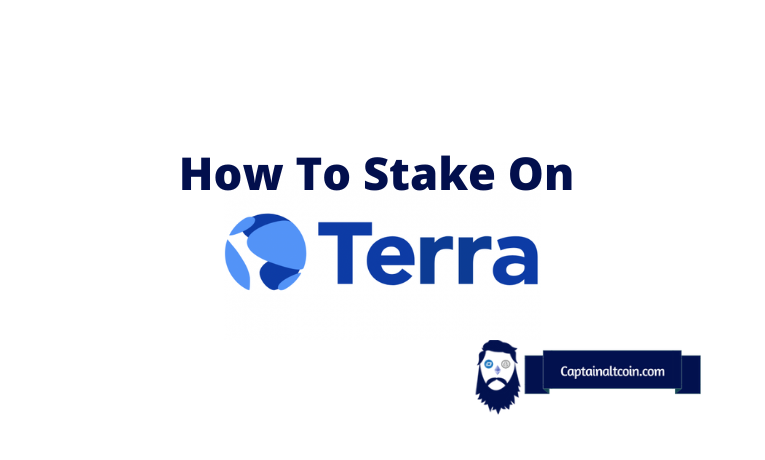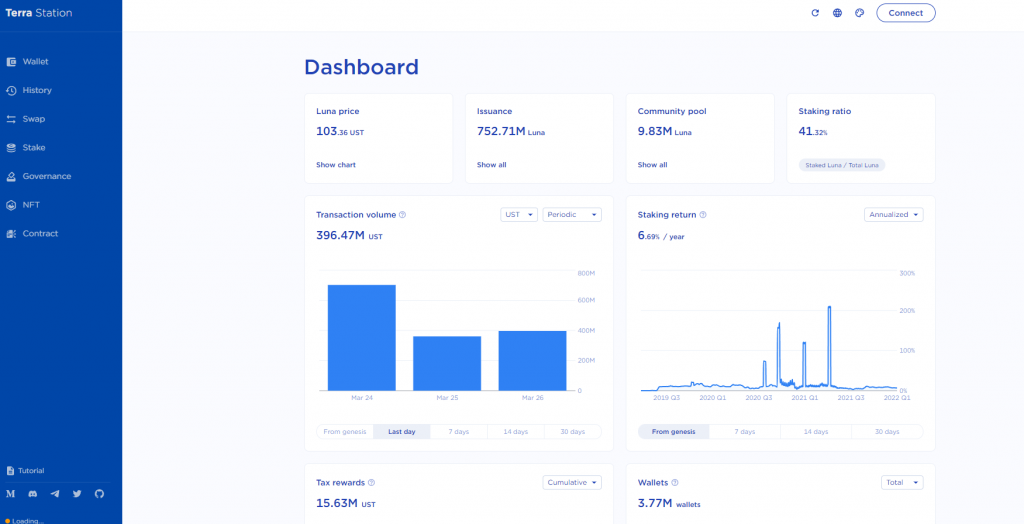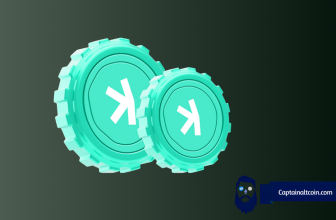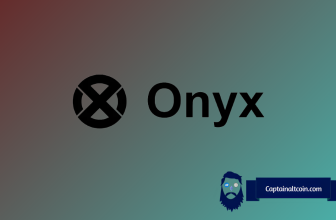
Terra Station is the authorized Terra cryptocurrencies wallet that allows LUNA (Terra cryptocurrencies) holders to store and access their funds. It’s a non-custodial system, so users can access their private keys, giving them complete control over their funds. Its dashboard offers data about the price of the LUNA.
Additionally, Terra allows users to compute the value of their coins, view and transfer NFTs from a custom set of NFT collections, see the active validators on the Terra network, send tokens to another, exchange currency on Terra at the rate of the day, earn rewards for staking LUNA, and participate in governance by voting on proposals and submitting their own.
What you'll learn 👉
Here is how to stake $LUNA and earn rewards in the Terra ecosystem
The first step is creating a Terra Station wallet and transferring your $LUNA from any exchanges you have bought them from or exchanging existing coins for Luna. Now you have your native tokens ready:
- Download Terra Station from the Chrome Web Store. Once downloaded, connect and create a new wallet. Keep your wallet information very safe.
- Once you have created your account on Terra Station, purchase and have your LUNA token transferred to your wallet from any exchanges such as Coinbase, Binance, Kucoin, and Bitfinex to your Terra wallet.
- Click the Staking tab in the global menu from the Terra Station wallet on the left.
- Select more than one different validator available. It’s recommendable to select active contributor validators with lower validator commissions and higher uptimes to ensure the lowest risk and maximum rewards.
- Then, click on the Delegate button and enter how many Luna you wish to delegate.
- On the delegation screen, click ‘Next’ and then ‘Next’ on the verification screen. Enter your password and click on Submit. The LUNA stake has been completed. You just need to monitor your rewards.
Note if you decide to stop staking, you will have 21 days to receive your tokens. You won’t be rewarded for stakes during this period, and the unstaked Luna cannot be traded.
Introduction to Staking

The staking process is to invest your cryptocurrency tokens as stakes to receive rewards for participating in new block validation on a Proof of Stake (PoS) blockchain.
In contrast to Proof of Work, where validators compete to solve cryptographic problems, the PoS network selects validators randomly while considering how much they staked and how long they held the stake.
Validators are rewarded for securing the network by holding stakes in the form of coins. However, if they do not, their stakes could be at risk.
Staking on Terra station
Terra Station makes it easier to stake or delegate your LUNA token. It’s advisable not to delegate LUNA if you intend to stake for short periods because if you decide to undelegate before the appointed time, you cannot sell your LUNA for 21 days.
When choosing a validator, check the uptime, uptime is how often the validators are online, and this is important because if they are offline, they are not earning rewards for you.
Also, check the validator commission, most new validators charge zero commission and experienced validators typically charge 5%. Checking the self-delegation of the validators is also essential to show that they are a real person or a team that works towards a good outcome with potential rewards from staked Terra (LUNA).
Staking on Stader labs
Stader Labs is another option for staking on Terra. It is challenging for users to find validators with a proven track record of consistent uptime, low delegation fees, and distinct features, such as airdrops. With Stader labs, users can discover and access the best validators in the blockchain with just one click, keep track of their status as well as maximize yields from vault strategies as add-on benefits are handled on their behalf while earning the highest yields based on their risk preferences.
While doing this, decentralization is also ensured in the ecosystem. Stader Labs built three validator pools (Airdrops Plus, Blue Chip, and Community). Each pool will consist of approximately 3-8 validators based on certain metrics; for instance, the Blue-Chip pool will be made up of validators in the top best metrics, such as commission, self-delegation, and uptime.
In November 2021, Stander lab launched Plain Staking and Liquid Staking, its main products. Let’s take a closer look at them.
Plain Staking
The Plain Staking process is almost identical to regular Staking in Terra Station. You select the best validators, delegate, earn rewards, and if you choose to unstake before time, you will have a 21-day unstaking period. In addition, Stander Labs provides several valuable features, including the validator pool, a curated pool of high-performing validators selected to provide optimal returns and minimize slashing. You will also benefit from automatic compounding of the LUNA and other rewards you earn from staking.
You can also earn stable coins in other currencies at Terra Station, including JPT and KRT. Additionally, Stader can help claim and swap these stablecoins into LUNA, as well as automatically stake them. They charge 3% of the rewards as staking fees for these benefits.
Liquid Staking
Liquid Staking will allow you to receive the benefits of staking while still being able to access your staked tokens instantly during the unstaking period, unlike Plain Staking, which you cannot access for a short period. LunaX makes it possible.
It is a liquid staking token created by Stader that enables instant unlocking of staked LUNA and is compatible with multiple DeFi protocols. As with other staking platforms, LunaX lets you take advantage of staking rewards and airdrops while also providing instant liquidity in instant unlocking. In addition, there are many other opportunities for enhancing yields, including creating new liquidity pools and using LunaX as collateral. Select the Pools tab in Stader, then Stake Luna to mint LunaX, then select Liquid Staking to mint LunaX.
Read also:
- Best NFTs on Terra Luna Blockchain
- Best Metaverse Projects on Terra
- Best NFT Marketplaces on Terra Luna Blockchain
- Ethereum to Terra Bridges – Send Crypto From ETH To Luna Blockchain
- Kucoin Pool-X Review
- FTX Staking Review
- Best Staking Platforms, Exchanges & Wallets
- Best Ethereum Staking Platforms & Pools
Overall Thought
Terra Station is a non-custodial wallet; that is, you have full control over your keys. It’s easy to buy LUNA, set up a secure wallet, delegate your LUNA and earn rewards on Terra Station.
Terra Station also provides global payment systems with decentralized and stable prices using fiat stablecoins currency. There has been a problem with price stability for the volatile cryptocurrency market, which has been addressed by Terra (LUNA).
Stader’s plain staking features are an excellent starting point for those new to staking. Still, once they understand DeFi and are looking into opportunities for a liquid staking token, they can then turn to Stader’s liquid staking with LunaX. Stader eliminates the need for users to carry out research on the best validators and also makes claiming rewards easier and more efficient.







